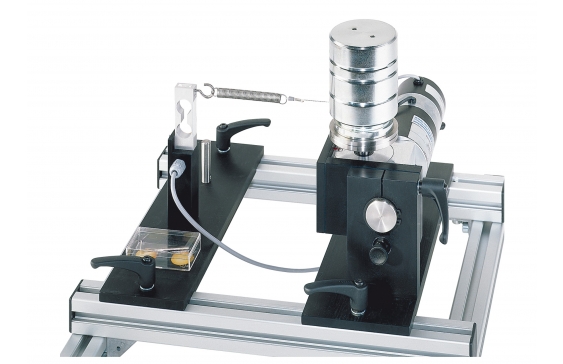TM 260.04 Frictional vibrations

Friction is the resistance of a body against movement on a base. Static friction means that a body remains at rest under the action of a force. If a limit value is exceeded, the body begins to move on the base, resulting in dynamic friction. Self-excited friction oscillations, also known as slip–stick phenomenon, occur if the static friction is significantly higher than the dynamic friction.
The tribological system in TM 260.04 allows a clear demonstration of the transition from static to dynamic friction and the occurrence of friction oscillations. The experimental unit contains a rotating stainless-steel disk and a loosely fitting friction ring as the friction pair. The contact force between the friction partners can be adjusted gradually up to a maximum of 40 N by means of weights.
A tension spring prevents the friction ring from rotating. The necessary holding force is measured by a force sensor.
The TM 260 drive unit is required in order to conduct experiments. The experimental unit is mounted quickly and easily on the frame of the drive unit with quick-action chucks. The disk is driven by a clampable coupling between drive unit and gear unit. The display and control unit of the drive unit shows frictional force and speed and allows the continuous adjustment of the speed.
The frictional force and the coefficient of friction can be determined in experiments. The frictional forces are measured by a force sensor. Friction rings made of different materials are included in the scope of delivery to study different friction pairings.
- slip–stick phenomenon at the transition from static to dynamic friction
- friction rings of different materials for the study of different friction pairings
Disk
- Ø: 60mm
- stainless steel
Friction ring
- outer diameter: 80mm
- inner diameter: 50mm
- 1x stainless steel
- 1x brass
- 1x plastic (PA)
Force sensor for frictional force
- 0…50N
Weights
- 1x 5N
- 3x 10N
- friction oscillations at static and dynamic friction
- quick and easy assembly of the experimental unit on the frame of the drive unit
- rotating stainless steel disk
- disk is driven by a clampable coupling between drive unit and gear unit
- friction ring of different materials: stainless steel, brass or plastic (PA)
- friction pair subject to load by stepped weights
- frictional force measured by force sensor
- displays of force and speed and speed adjustment on the drive unit
together with the drive unit
- observation of the transition from static to dynamic friction
- influence of lubrication on slip–stick phenomenon
- influence of the force between the friction partners on the slip–stick phenomenon
- influence of the relative velocity of the friction partners on the slip–stick phenomenon
